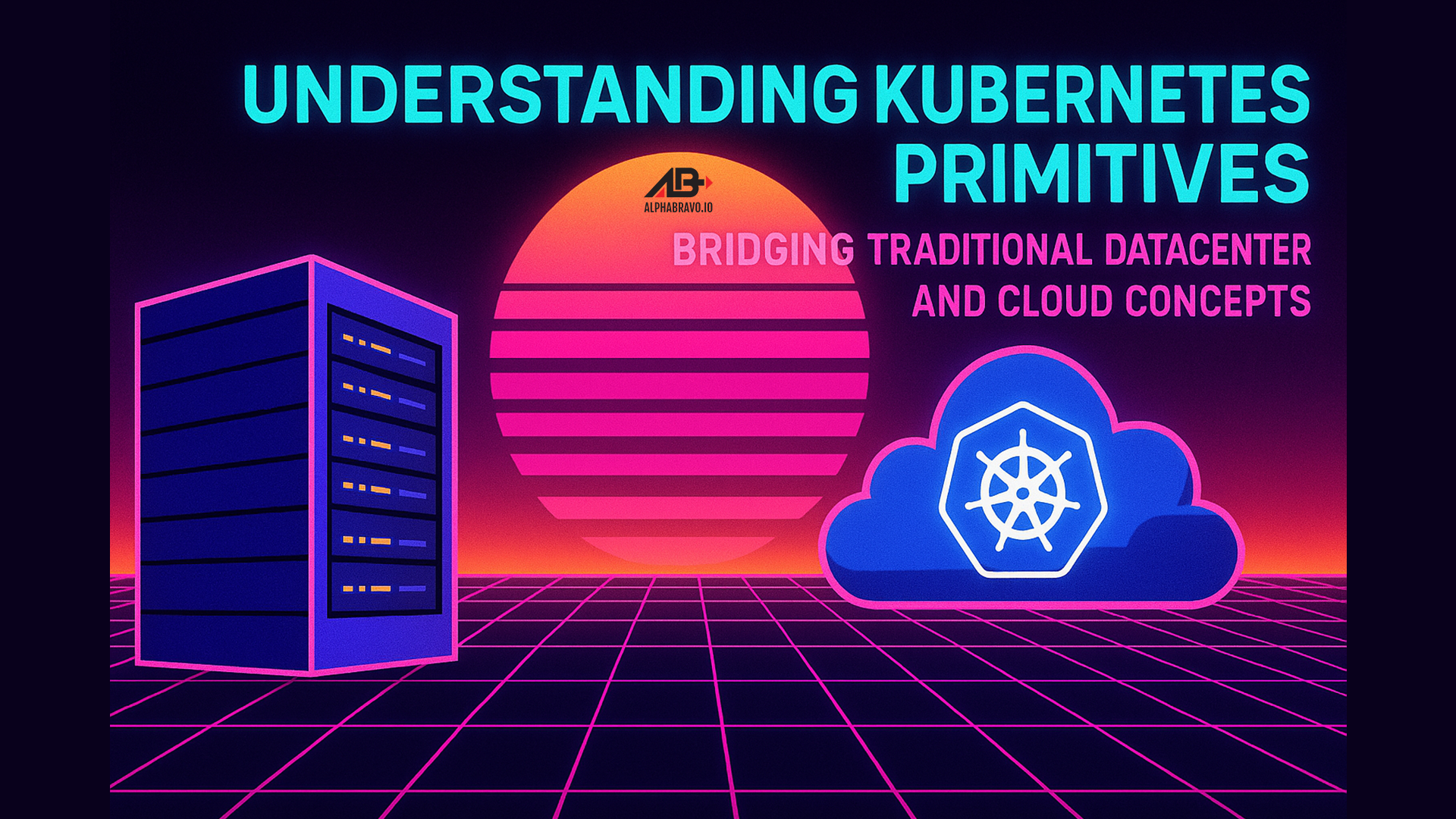
Understanding Kubernetes Primitives: Bridging Traditional Datacenter and Cloud Concepts
Kubernetes has revolutionized how we deploy, scale, and manage containerized applications. For professionals transitioning from traditional datacenter environments or other cloud platforms, understanding how Kubernetes primitives relate to familiar concepts can significantly accelerate the learning curve. This blog post explores the core building blocks of Kubernetes and draws parallels to their datacenter and cloud counterparts.
Kubernetes Architecture: The Foundation
Before diving into specific primitives, it’s important to understand Kubernetes’ overall architecture. A Kubernetes cluster consists of a control plane plus worker nodes that run containerized applications. This architecture follows a master-worker paradigm similar to many distributed systems in traditional datacenters.
Control Plane Components
The control plane manages the cluster and makes global decisions. Key components include:
-
API Server: Acts as the front-end for the Kubernetes control plane, handling all REST operations and serving as the gateway for all API requests. Similar to an API gateway in traditional architectures.
-
etcd: A distributed key-value store that holds all cluster data, including the state and configuration of the entire cluster. Comparable to configuration databases in traditional environments.
-
Controller Manager: Regulates the desired state of the cluster, similar to orchestration engines in traditional datacenters.
-
Scheduler: Places pods onto nodes based on resource availability and constraints, functioning like a resource scheduler in virtualized environments.
Worker Nodes
Worker nodes host the pods that run application workloads. These include:
-
kubelet: Ensures containers are running as expected, similar to hypervisor agents in VM environments.
-
kube-proxy: Manages network routing within the cluster, comparable to software-defined networking components in modern datacenters.
-
Container Runtime: The underlying software responsible for running containers, replacing traditional hypervisors in many cases.
Core Kubernetes Primitives and Their Datacenter Counterparts
Pods: The Fundamental Compute Unit
Pods are the smallest deployable units in Kubernetes, encapsulating one or more containers with shared resources. They represent a single instance of a running process.
Datacenter/Cloud Parallel: Virtual machines in traditional infrastructure. However, while VMs typically run entire operating systems, pods are more lightweight and ephemeral, designed for microservices architectures. Pods share networking and storage contexts, making them more like tightly coupled processes than isolated VMs.
Services: Stable Network Endpoints
Kubernetes pods are ephemeral—they can be created, destroyed, or rescheduled at any time. Services provide a stable network identity for a set of pods, acting as an abstraction layer.
Datacenter/Cloud Parallel: Load balancers in traditional infrastructure. A Kubernetes Service functions similarly to a datacenter load balancer, distributing traffic across multiple application instances. Different service types mimic various load balancer configurations:
- ClusterIP: Similar to an internal load balancer, exposing the service only within the cluster.
- NodePort: Comparable to a layer 4 port forwarding, exposing the service on a static port across all nodes.
- LoadBalancer: Directly analogous to external cloud provider load balancers, exposing services outside the cluster using cloud infrastructure.
A Kubernetes LoadBalancer service acts as a traffic manager, ensuring incoming requests are evenly distributed among available instances to optimize performance and prevent overload on any single instance—the core function of traditional load balancers.
Deployments: Managing Application Lifecycle
Deployments provide declarative updates to Pods and ReplicaSets, enabling definition of desired application state.
Datacenter/Cloud Parallel: Server farms or auto-scaling groups in cloud environments. Deployments manage application replica counts, rollout strategies, and version upgrades—similar to how autoscaling groups manage VM fleets, but with more sophisticated update mechanisms built in.
Key features include:
- Rolling updates that gradually update pods without downtime
- Rollback capabilities to revert to previous versions
- Automated scaling based on defined parameters
ConfigMaps and Secrets: Configuration Management
ConfigMaps store non-sensitive configuration data as key-value pairs, while Secrets store sensitive information like passwords and tokens.
Datacenter/Cloud Parallel: Configuration management systems and credential vaults. ConfigMaps are similar to configuration files or environment variables in traditional systems, while Secrets function like credential stores (e.g., HashiCorp Vault, AWS Secrets Manager).
The key advantage in Kubernetes is the native integration with application lifecycle, allowing dynamic configuration updates without rebuilding container images.
Persistent Volumes and Claims: Storage Abstraction
Kubernetes storage primitives allow applications to use persistent storage independent of pod lifecycles:
- Persistent Volumes (PV): Represent physical storage resources provisioned by an administrator.
- Persistent Volume Claims (PVC): Requests for storage resources by users.
Datacenter/Cloud Parallel: SANs, NAS, and cloud storage services. The PV/PVC model abstracts the underlying storage technology, similar to how storage abstractions work in virtualized datacenters. This allows applications to request storage without needing to understand the underlying implementation details.
As described in the search results, “Persistent Volume Claims are a way to decouple the storage needs of a pod from the actual realization of the storage”, which mirrors how storage is often provisioned in enterprise environments.
Namespaces: Multi-Tenancy and Resource Isolation
Namespaces provide a mechanism for isolating groups of resources within a single cluster, allowing for logical separation of workloads.
Datacenter/Cloud Parallel: Tenant isolation in multi-tenant environments. Namespaces in Kubernetes provide similar functionality to account/project isolation in cloud platforms or network segmentation in traditional datacenters. They help organizations separate resources by teams, projects, or environments (dev, staging, production).
Running Kubernetes: Cloud vs. On-Premises Considerations
Organizations must decide between deploying Kubernetes in the cloud or on-premises based on their specific requirements.
Cloud-Based Kubernetes
Benefits:
- Reduced infrastructure management overhead
- Native integration with cloud provider services
- Simplified scaling and redundancy Considerations:
- Potential vendor lock-in with managed Kubernetes services
- Higher operational costs for large-scale deployments
- Less control over underlying infrastructure
On-Premises Kubernetes
Benefits:
- Greater control over infrastructure
- Potential cost savings for large, stable workloads
- Better regulatory compliance for sensitive workloads Implementation Approaches:
- Using tools like kubeadm for bootstrapping clusters
- Implementing CI processes to build VM images containing bootstrapped clusters
- Using network booting for new nodes The choice between cloud and on-premises deployment often depends on existing investments, expertise, and specific application requirements. Many organizations adopt hybrid approaches, running some clusters on-premises and others in the cloud.
Advanced Kubernetes Primitives for Specialized Workloads
Beyond the core primitives, Kubernetes offers specialized resources for complex workloads:
StatefulSets: Stateful Application Management
StatefulSets are designed for applications that require stable network identities and persistent storage, such as databases and distributed systems.
Datacenter/Cloud Parallel: Database clusters and other stateful services in traditional environments. StatefulSets provide predictable pod naming and ordering, equivalent to how database administrators would manage primary and replica instances.
DaemonSets: Node-Level Services
DaemonSets ensure that all (or some) nodes run a copy of a pod, typically used for cluster-wide services like monitoring agents or log collectors.
Datacenter/Cloud Parallel: Agent-based services that run on every server in traditional environments, such as monitoring agents, backup tools, or security scanners.
Custom Resource Definitions (CRDs)
CRDs extend the Kubernetes API, allowing for domain-specific abstractions and workflows.
Datacenter/Cloud Parallel: Specialized middleware platforms and service orchestration tools. CRDs enable Kubernetes to manage domain-specific workloads with the same declarative approach used for standard resources.
Managing Kubernetes at Scale: From Individual Clusters to Fleet Management
For organizations running multiple Kubernetes clusters across different environments, managing the fleet becomes a significant challenge.
Cluster Management Solutions
Tools like Gardener are designed to manage Kubernetes clusters as a service, providing Kubernetes-conformant clusters on various cloud providers with the ability to maintain hundreds or thousands of them at scale.
Datacenter/Cloud Parallel: Enterprise management frameworks that oversee multiple datacenter environments or cloud accounts. These solutions abstract away the complexity of individual infrastructure components to provide a unified management plane.
Conclusion
Kubernetes primitives provide powerful abstractions that map conceptually to many traditional datacenter and cloud concepts but with enhanced capabilities designed for container-based architectures. Understanding these parallels can help infrastructure professionals leverage their existing knowledge while adapting to the cloud-native paradigm.
The true power of Kubernetes lies in its ability to abstract infrastructure details while providing a consistent operational model across environments. By relating Kubernetes primitives to familiar concepts, teams can more easily adopt this powerful platform and fully exploit its capabilities for modern application deployment.
Whether you’re running in the cloud or on-premises, Kubernetes primitives offer a standardized way to deploy, scale, and manage applications—bridging the gap between traditional infrastructure approaches and modern containerized architectures.
